 Phoenix: Masonic Metropolis in the Valley of the Sun
Phoenix: Masonic Metropolis in the Valley of the Sun
2006 10 21
By Gary A David | theorionzone.com
Picked up from: book-of-thoth.com

Turquoise swimming pools when seen from above shimmer like a squash blossom necklace on a jet setter’s tanned breast. Imported palm trees tower over a surrendering army of native saguaros, while skyscraper mirages of steel and glass gleam in the distance. This western metropolis pushes out more than up though, sprawling over 450 square miles.
With the sixth largest population in the U.S., the Valley of the Sun attracts all kinds: retirees golfing their way into oblivion, snowbirds fleeing subzero winters, young construction workers cashing in on frenzied economic growth.
Shopping malls, parking lots, concrete clover leafs, subdivisions, and apartments relentlessly eat away at the mesquite and ironwood at the rate of "an acre an hour."
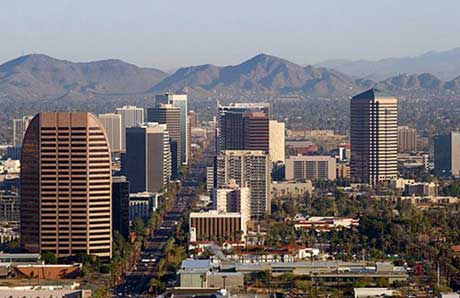
Skyline in Phoenix, Arizona, 2004. This view looks north along Central Avenue toward the Phoenix Mountains.
Summer temperatures routinely soar over 100 degrees. Before air conditioning, the Sonoran Desert must have been unbearable. Where once rattlesnakes, scorpions, centipedes, tarantulas, and Gila monsters reigned over the sand, now gang wars, drug money, prostitution, Mafia murders and other urban amenities civilize the asphalt. In other words, an aura of the foreign and bizarre pervades Phoenix. What exactly attracted early settlers to this hard and uncompromising landscape.
A Local Habitation and a Name

Darrell Duppa, who named the city of Phoenix, Arizona |
In the autumn of 1867 Bryan Philip Darrell Duppa and other founding fathers of the fledgling city were picnicking on the platform mound at Pueblo Grande near what is now the intersection of East Washington and 44th streets near Phoenix Sky Harbor airport. Someone asked what this future municipality should be named. A Southerner in the party wanted to call it Stonewall, after the Confederate general. Another idly offered the appellation Salina, meaning "salt marsh," but that too was voted down. Then Duppa spoke: "This canal was constructed in an age now forgotten. Prehistoric cities lie in ruins all around you. A great ancient civilization once thrived in this valley. Let the new city arise from its ashes. Let it be called Phoenix."
Both the platform mound and the canal had been built by the Hohokam who inhabited the basin as early as 300 BCE. The flat-topped mound (shaped like a Mayan pyramid) measures 300 feet long, 150 feet wide and 20 feet high. Lacking draft animals and wheelbarrows, these industrious Native Americans also dug 500 miles of aqueducts to irrigate over 25,000 acres. The main channels were 75 feet across and 12 feet deep. H. M. Wormington, one of the first archeologists in the region, believed that the construction of this extensive system rivaled the architectural achievements of the Egyptian pyramids or the Mayan temples. Duppa would have probably agreed.
Born into English landed gentry, "Lord" Darrell Duppa was one of the best-educated men in the American West. Classically trained in Paris and Madrid, he knew French, Spanish, Italian Latin, and Greek. The library that he carried with him into the wilderness included Ovid, Juvenal, and Homer in the original. An eccentric and a loner, he occasionally was given to fits of eloquence and could quote Shakespeare by the hour, especially if facilitated by a shot or two of whisky.
Months earlier Duppa had been seen in Prescott, the new prospecting town a hundred miles to the north. His ostensible business was to check up on some gold mining claims owned by his prosperous uncle, whose New Zealand sheep ranch he had helped to establish. Before arriving in Arizona, Duppa had traveled extensively throughout Australia and was the sole survivor of a shipwreck off the coast of Chile. Although water rather than fire was the threatening element, this event may give a clue to his personal choice for the name.
Duppa was alluding to the description of the mythical phoenix by the Greek historian Herodotus. At the end of each temporal cycle this brilliantly plumed male bird flies to Heliopolis in Egypt and builds a nest of cassia twigs in a myrrh tree as his pyre upon which he will be resurrected. Thus a new cycle is initiated. All this scholarship must have impressed the settlers, because the name began to be used officially. Or so the official story goes.
Birds of a Feather
Perhaps it is no accident that most of the first citizens of Phoenix, including Duppa, were Freemasons.
John T. Alsap, for instance, was an attorney, judge, first territorial treasurer and first mayor of Phoenix. He also served as the first worshipful master of Arizona Lodge No. 2 as well as the first grand master of the Masonic Grand Lodge of Arizona. Even earlier, he had been first master of Arizona’s first Masonic Lodge called Aztlan, located in Prescott, the first territorial capital. (A lot of "firsts" here.)
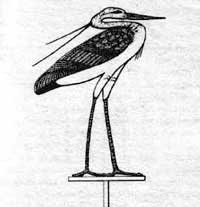
Egyptian Bennu bird |
Aztlan is a Nahuatl word meaning "place of the heron." The Aztecs inhabited this mythical land after emerging from the Seven Caves located in the bowels of the earth. The heron is thought to be the naturalistic model for both the phoenix and the Bennu bird. In the Egyptian sun cult the Bennu was found perched atop an obelisk or sometimes upon a pyramid-shaped stone of meteoric iron called a Benben.
As a primo symbol of morning and new life, the Egyptian heron passes with flying colors (no pun intended). Likewise, the Bennu embodies the morning star Venus, appearing each dawn on the laurel tree in Heliopolis. This ornithological curiosity is also the incarnation of the heart (or ab) of Osiris and the soul (or ba) of Ra, two primary deities related by a simple palindrome. In addition, the heron and the Bennu were among a small number of animals, including the hawk and the serpent, in which a discarnate soul could inhabit for as long as it wished.
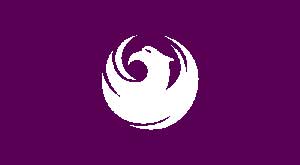
Flag of the city of Phoenix, Arizona |
The hieroglyph for bennu means both "purple heron" (Ardea purpurea) and "palm tree." One denotation for the word "phoenix" is "purple-red"; consequently, the Phoenicians were known as "red men." Even today residents of Phoenix, Arizona are known as Phoenicians. The flag of the city is a stylized white phoenix on a purple background.
In a tome called Morals and Dogma of the Ancient and Accepted Scottish Rite of Freemasonry, 33rd-degree Mason Albert Pike states that the phoenix was a quintessential alchemical icon. In this regard J.E. Cirlot’s Dictionary of Symbols remarks: "In alchemy, [the phoenix] corresponds to the colour red, to the regeneration of universal life and to the successful completion of a process." Some Arizona prospectors may indeed have been seeking spiritual gold.
Is it more than mere coincidence, then, that the phoenix, whose center of worship was the Pre-Dynastic City of the Sun, should lend its name to what would become the largest city in the Valley of the Sun? Is the name something more than the whim of some erudite inebriate misplaced in the hinterlands of America?
Aztlan is furthermore conceptualized as an island, and some speculate that the name even refers to the legendary continent of Atlantis. According to comparative linguistics scholar Gene D. Matlock in The Last Atlantis Book, the Aztlán of Nahuatl mythology was really called Aztatlán, referring to the village of Nayarit on Mexico’s western coast. The Sanskrit word Asta apparently means "Place of the Setting Sun." Matlock suggests that this could actually be the westernmost boundary of what was once Atlantis.
Did Lord Duppa and Judge Alsap consciously try to merge Egyptian and Mesoamerican mythologies in the wilds of Arizona? Alsap’s Bachelor of Law and Doctor of Medicine degrees prove that he was no dummy himself. Was the establishment of Aztlan (Masonic Lodge No.1) and Phoenix (Masonic Lodge No. 2) an attempt to symbolically merge Prescott (the heron) and Phoenix (the Bennu) in the same way they would soon actually be linked by stagecoach? Was it a clandestine Masonic intent that a new Atlantis (Aztlan) should rise in Arizona and a new Heliopolis (Phoenix) should be its heart?
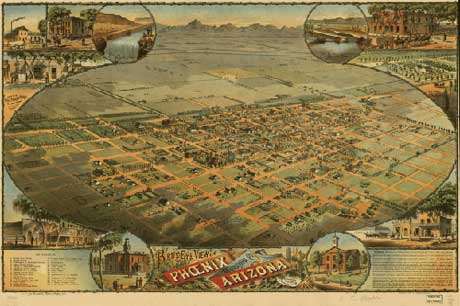
Panoramic view of Phoenix by C. J. Dyer in 1885. (MARC Map Collection)
Source: Library of Congress, Special Collections
Who’s Story
Other questions about the initial territorial capital come to mind. Why was Prescott named to honor the prominent 19th century historian William Hickling Prescott, who never set foot in the town? Were the run-of-the-mill settlers really all that interested in his book History of the Conquest of Mexico? According to its author, "The inhabitants, members of different tribes, and speaking dialects somewhat different, belonged to the same great family of nations who had come from the real or imaginary region of Aztlan, in the far north-west." In other words, the Arizona Territory. Is this why two major thoroughfares in the town of Prescott are named Cortez Street and Montezuma Street?
Why did the territorial capital suddenly shift in 1889 from Prescott to Phoenix? The mercantile owner, postmaster, and territorial representative John Y.T. Smith greatly influenced this movement. He too was another "pioneer Mason" of Phoenix. After governmental authority had finally rested with the southern city, spiritual symbolism superseded natural potency. Did secret powers dictate that instead of the heron the phoenix should arise?
Whatever the reason, Columbus H. Gray, who served as a territorial senator and member of Maricopa County’s Board of Supervisors, began during Phoenix’s early years to construct a Masonic hall at the corner of Jefferson and First streets. Before it was completed, he sold it to Mike Goldwater, grandfather of Arizona Senator Barry Goldwater, himself a 33rd-degree Mason. Incidentally, Phoenix is located at 33 degrees north latitude.
By 1890 a number of the fraternal organizations were operating in the city: Masons, Odd Fellows, Knights of Pythias, Ancient Order of United Workmen, Grand Army of the Republic, Chosen Friends and Good Templars.
Darrell Duppa spent his last days in the Valley of the Sun and crossed the bar in 1892. He was initially buried in the Odd Fellows Cemetery but later re-interred in Greenwood Memorial Cemetery.
"Membership in both the Masons and Odd Fellows has been common as evidenced by numerous pins showing the square and compass conjoined with the three link chain." (www.phoenixmasonry.org)
The Odd Fellows’ symbol of three links represents the principal tenants of Friendship, Love, and Truth, whereas Freemasonry’s square and compass signify Earth (matter) and Heaven (spirit) respectively.
Further evidence of Duppa’s Masonic association comes from one source that connects him to Jacob Waltz, the famous Lost Dutchman, by identifying both men as Masons. This German prospector supposedly discovered a fabulous gold mine in the Superstition Mountains east of Phoenix. As with many lost treasures of the Wild West, its location remains a mystery.
Masonic influence in Phoenix continued well into the twentieth century. Arizona’s first governor, George Wiley Paul Hunt, served seven terms between 1912 (the year of statehood) and 1932. He was also a prominent and longstanding Freemason. As a populist and supporter of trade unions, he spoke and wrote in a simple and sometimes grammatically incorrect style. Nonetheless, like Duppa, he loved classical literature, which gained him the moniker "Old Roman." A man of contradictions, Hunt had also been known to address Theosophical Society meetings.
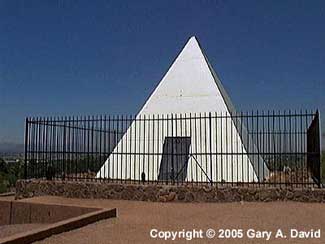
Mausoleum of George Hunt, seven-term governor and Freemason |
His final resting place in Phoenix’s Papago Park is within sight of an archaeo-astronomical observatory once used by the Hohokam but now called Hole-in-the-Rock. Oddly enough, Hunt’s family mausoleum was contructed in the style ;;of a white-tiled Egyptian pyramid.
Alas, Poor Geronimo
Many local history buffs portray early pioneers as hardy, pragmatic individualists who were more concerned with prospecting, gambling, and imbibing red-eye than with studying arcane lore. In most cases, this is probably true. In the same sense, most Masons are ordinary businessmen who just want to further their careers while enjoying camaraderie and offering charity to the community at large.
However, inside each citizenry and each lodge exists a cabal of operatives who long to achieve power and further their own ultimate goals or those of their ancient organization. B.P. Darrell Duppa and John T. Alsap may have been such men.
An even more insidious instance of power and wealth was Prescott Sheldon Bush (1895-1972). He was father of the forty-first U.S. president George Herbert Walker Bush and grandfather of the forty-third president George W. Bush. All three had been members of the notorious Skull and Bones Society, ;;an elite, quasi-Masonic fraternity at Yale University.
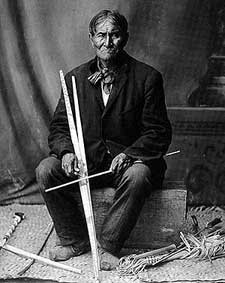
Geronimo, Apache warrior at the St. Louis World’s Fair, 1904 |
Possibly the eldest Bush was named after his distant relative William Hickling Prescott, the historian noted above. In 1918 Bush allegedly purloined the skull of the famous Arizona Apache warrior Geronimo from its resting place at Fort Sill, Oklahoma and took it back to the secret society’s meeting hall to be displayed in a glass case. The motive for this savage act is unclear, but it may have involved retribution for the 1869 killing of settler James G. Sheldon from Maine by Apaches at Camp Willow Grove west of Prescott. Sheldon, after whom a major street in Prescott was named, is perhaps a relative of Prescott Sheldon Bush, or he may merely be a namesake whom Bush was trying to avenge.
Bush was later elected as a U.S. senator from Connecticut. His son and grandson, of course, each became president. The Bush vacation home is located in Kennebunkport, Maine. Geronimo’s skull has never been recovered.
And Phoenix remains an enigmatic talisman whose Masonic roots reach deep into the desert of the American Southwest.
an excerpt from The Orion Zone: Ancient Star Cities of the American Southwest
Copyright © 2005 by Gary A. David. All rights reserved
Gary A. David is an independent researcher and writer living in northern Arizona. The Orion Zone: Ancient Star Cities of the American Southwest will be published by Adventures Unlimited Press in November of 2006. (See http://www.theorionzone.com/ .) This book discusses a correlation between the stars of Orion and the Hopi villages and ruins in the Four Corners region of the US. Recently Mr. David’s articles have appeared in Atlantis Rising and World Explorer magazines.
Article from http://www.book-of-thoth.com/article1636.html
Comment on this article
Related: Along the 33rd Parallel: A Global Mystery Circle
Celestial and Mathematical Precision in Ancient Architecture
Old churches reveal early knowledge of astronomy
An Interview With Graham Hancock
Quantum physics and qi
|


|
